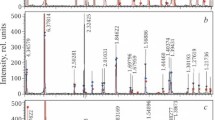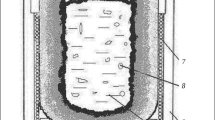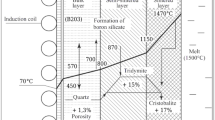Results are reported from a study of the effects of temperature on the enthalpy and heat capacity of quartzite. These effects lead to changes in the crystalline lattice of quartzite. Quartzite is used in the lining of crucible-equipped industrial-frequency induction furnaces. The patterns of change in the enthalpy and heat capacity of quartzite during service are determined, and it is established that these changes are related to phase transformations in the lattice and properties of the material that affect the durability of the lining.
Similar content being viewed by others
Avoid common mistakes on your manuscript.
Most crucible-equipped industrial-frequency induction furnaces have an acid lining based on quartzite. The quartzite is subjected to the effects of various types of factors during service: thermal effects — the high temperatures of the molten metal and sharp fluctuations in temperature during heating and cooling, particularly during the introduction of a cold charge; mechanical effects — the high pressure exerted by the liquid metal, mechanical loading by the solid charge materials during the charging operation, the erosive action of the moving melt under the influence of electromagnetic forces, compressive and tensile forces created during the rotation of the furnace, vibration of the induction coil; chemical factors — reactions between the melt, the slag, and the material of the lining. Thus, the compacted and sintered lining of the furnace needs to have the following characteristics:
-
resistance to the action of the liquid metal when it is at its working temperature and when its temperature randomly rises above that point;
-
the ability to function during the normal temperature cycles in the furnace and during the repeat melting of the metal after it solidifies;
-
adequate mechanical strength in the cold state and at the working temperature for the refining operation without any significant loss of mechanical properties;
-
the ability to be removed at the end of the campaign without having the induction coil damaged;
-
the existence of a large temperature gradient between the melt and the coil, since the metal should rapidly crystallize (solidify) if it enters the lining; that will avoid having molten metal melt the coil;
-
good resistance to erosion and corrosion.
Silica (quartzite) is the very material that (with allowance for its cost) can meet the above requirements if certain conditions are met. It can do so because of its polymorphism: a transformation to lighter-weight modifications accompanied by an increase in volume compensates for the shrinkage of the lining during sintering and stabilizes its volume during frequent thermal cycling [1]. The service properties of quartzite are determined by its chemical composition and, even more so, by its structure and the phase transformations which take place in it. Those transformations are accompanied by changes in enthalpy and heat capacity. Previous studies have found that polymorphic transformations take place in quartzite at 117, 270, 573, 1025, and 1470°C. In addition, proper operation of a crucible-type induction furnace requires a knowledge of how the lining will perform at the following temperatures: 1550°C — the temperature that the lining is held at at the end of its sintering; 1000 – 1050°C—the temperatures to which the furnace cools when the first batch of metal is being tapped without additional cold-charging; 1450 – 1470°C — the temperature at which the metal is discharged, the exact temperature within this range depending on the grade of the metal being made; 800 – 900°C — the temperature to which the lining cools during discharge of a batch of metal and charging of the next batch.
The goal of the experiments we performed was to establish the laws that govern the changes in the crystalline lattice of quartzite as it is heated during the sintering operation and the changes in the temperature regime during the operation of the furnace. The material that was tested was quartzite of grade PKMI-2, which is made by the OAO “Dinur” in accordance with the standard TU 1511-022-00190495–2003. A synchronous thermal analysis was performed on the instrument “NETZSCH STA 449C Jupiter” with a heating rate of 10 K/min. Data points were collected at a rate of 100 points/min during the analysis.
Two corundum crucibles were used. The test specimen was placed in one crucible and the other crucible served as the control. The crucible material was chosen based on the highest temperature to which the specimen and the test material would be heated. The material should not react with crucible in the course of the experiment. To ensure accurate measurement, the area of contact between the specimen and the bottom of the crucible was made as large as possible and test material was distributed over the crucible as evenly as possible [2]. First, two experiments were conducted with the use of the following regimes for drying (calcining) the raw quartzite: 1 — heating to 800°C and holding at that temperature for 2 h; 2- heating to 200°C and holding at that temperature for 4 h. The results are shown in Fig. 1.
An intensive exothermic phase transformation took place at 570°C in the quartzite that was calcined by regime 1. This transformation was characterized on the derivatogram by the area of the peak or the area of the thermal effect (enthalpy) associated the formation of the new phase, which was numerically equal to –367.3 mJ. The phase transformation was accompanied by the formation of a looser state of aggregation (an increase in volume and a decrease in density due to expansion of the crystalline lattice). No such changes were seen in the quartzite calcined by regime 2.
After the quartzite was dried and cooled, a lining composition was prepared in accordance with the standard practice and was rammed into place and sintered in accordance with a special schedule. The maximum sintering temperature was 1500 – 1550°C. The changes that took place in the quartzite (during the sintering of the lining) are shown in Fig. 2. Heating to 1550°C was accompanied by exothermic phase transformations. Roughly twice as much heat was released (in absolute terms) in the case of the quartz that was calcined at 800°C.
The next stage of the investigation entailed studying quartzite at the temperatures that correspond to the service temperatures of the lining during refining (1470 – 1250 – 870°) immediately after sintering (four refining cycles were studied). These regimes were maintained until the lining had completely worn, i.e. until it was removed from the furnace. As long as the furnace is operated properly, the lining can last 350 – 380 heats. The exact service life in a specific case depends on the capacity of the furnace [3]. Thus, both varieties of quartzite were subjected to further investigation in the above-described temperature regimes (Fig. 3). The data that was obtained was used to construct graphs of the changes in the enthalpy and heat capacity of the quartzite (Fig. 4). The following conclusions can drawn from these graphs:
-
after analyzing the graph that describes the change in the enthalpy of the quartzite calcined at 200°C and was constructed based on the areas of the peaks which were proportional to the thermal effect or enthalpy, it can be concluded that the process of heat absorption takes place nearly twice as intensively as the process of heat transfer. For this reason, the decrease in the volume of the material is greater than the increase in volume and higher-density phases are formed;
-
the graph of the change in heat capacity shows that the λ-like jumps connected with phase transformations are quite large. This means that the phase which is being formed has a denser atomic packing;
-
the heat transfer which takes place in the case of quartzite calcined at 800°C is 130% greater than the heat absorption. The total amount of heat expended on phase transformations is 17.7% greater and the λ-like jumps on the graph of heat capacity are 20% smaller than in the case of the quartzite calcined at 200°C;
-
all of the changes take place in the layer of the lining that undergoes sintering (in the sintered layer). This layer should have a high density and should release as little heat as possible to the unsintered or buffer layer. The sintered layer should also compensate for volumetric changes in the lining and thus help prevent the formation of large cracks that could be penetrated by the liquid metal. Based on the proceeding, quartzite that is calcined at 200°C provides the lining with more resistance to wear by liquid metal, transfers less heat to the semi-sintered layer, and slows the wear of the lining as a whole;
-
from an economic standpoint, the use of quartzite calcined at 200°C is very cost-effective because it reduces electric power consumption, allows the use of low-temperature furnaces, and eliminates the need for containers made of heat-resistant alloys.
References
B. P. Platonov, A. D. Akimenko, S. M. Bagutskaya, et al., Induction Furnaces for Melting Cast Iron [in Russian], Mashinostroenie, Moscow (1976).
N. D. Topor, et al., Thermal Analysis of Minerals and Inorganic Compounds [in Russian], MGK, Moscow (1987).
V. A. Kukartsev and A. K. Abkaryan, “Study by x-ray methods of the effect of temperature on crystal lattice interplanar distances of Pervoural’sk quartzite used for induction furnace lining,” Novye Ogneupory, No. 10, 44 – 46 (2013).
Author information
Authors and Affiliations
Corresponding author
Additional information
Translated from Novye Ogneupory, No. 5, pp. 33 – 35, May, 2014.
Rights and permissions
About this article
Cite this article
Kukartsev, V.A., Trunova, A.I. & Kukartsev, A.V. Thermal Analysis of Quartzite Used to Line a Crucible-Equipped Industrial-Frequency Induction Furnace. Refract Ind Ceram 55, 220–222 (2014). https://doi.org/10.1007/s11148-014-9692-1
Received:
Published:
Issue Date:
DOI: https://doi.org/10.1007/s11148-014-9692-1








